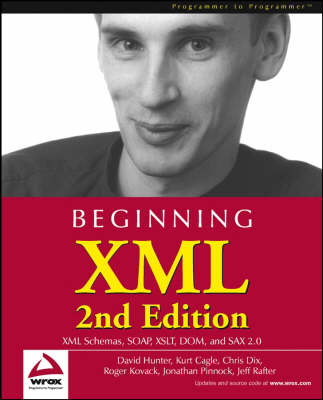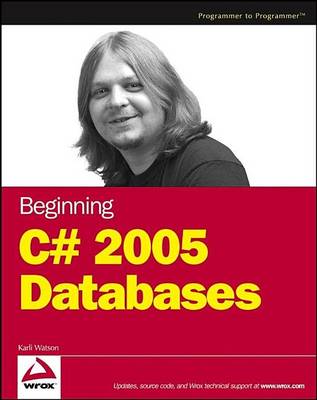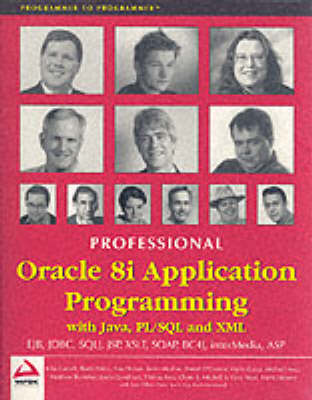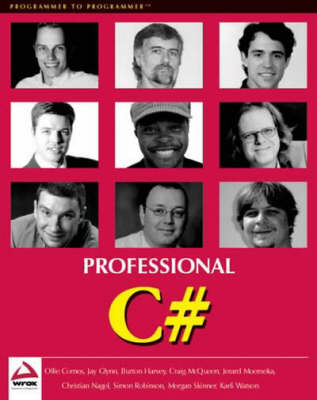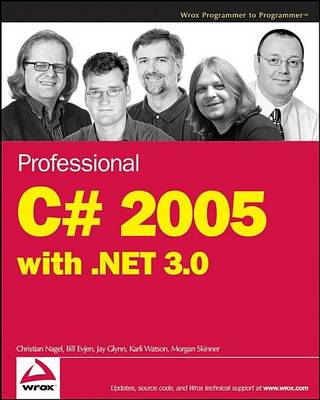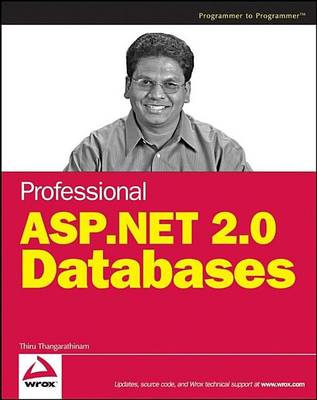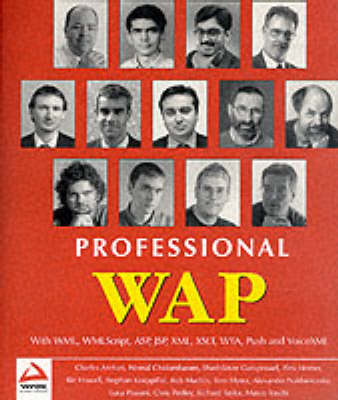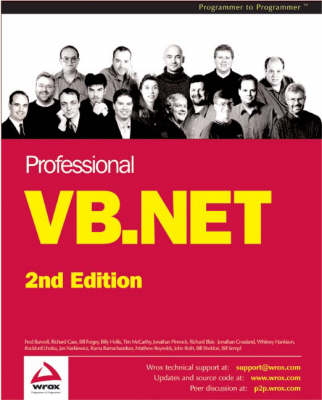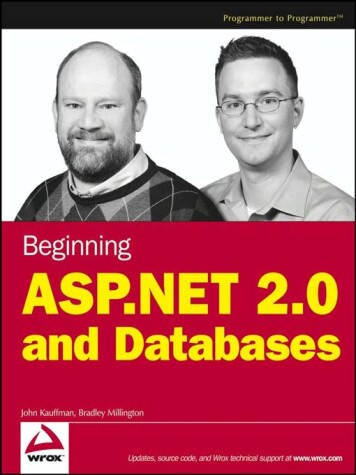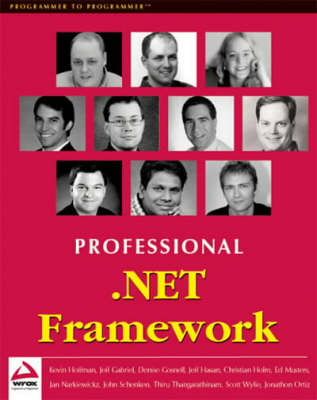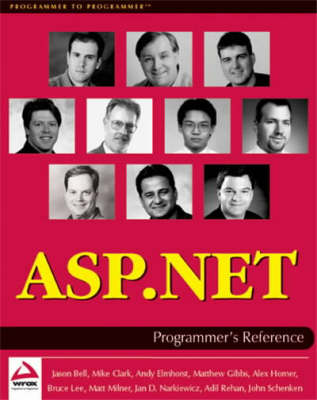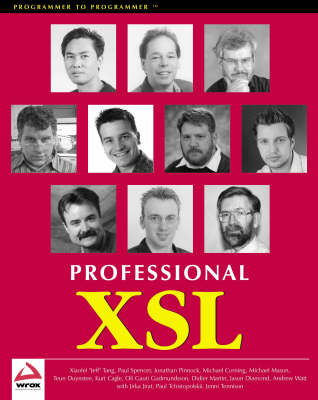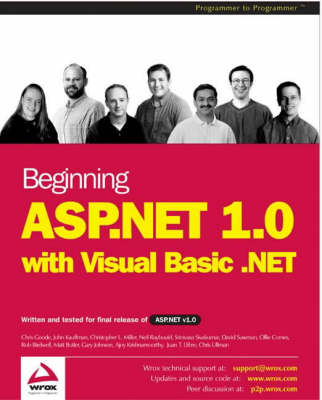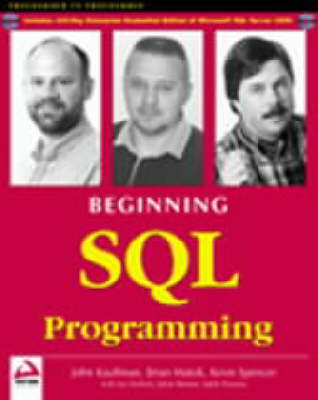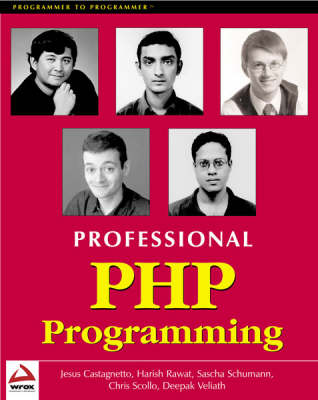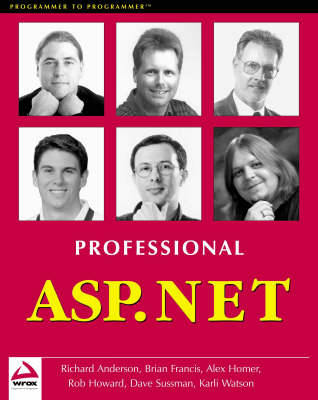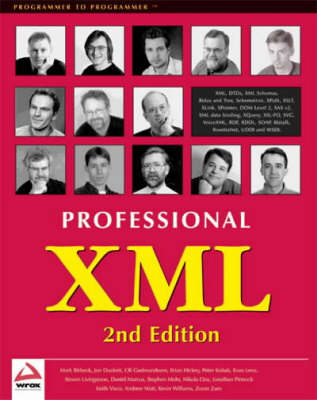Programmer to programmer
32 total works
* SOAP and Web Services * Displaying XML using CSS and XSL * Incorporating XML into tradition databases and n-tier architectures * XLink and XPointer for linking XML and non-XML resources Who is this book for? Beginning XML, 2nd Edition is for any developer who is interested in learning to use XML in web, e-commerce or data-storage applications. Some knowledge of mark up, scripting, and/or object oriented programming languages is advantageous, but not essential, as the basis of these techniques are explained as required.
Professional Oracle 8i Application Programming
by Michael Awai, Matthew Bortniker, Daniel O'Connor, Gary Nicol, and Et Al
Professional C#
by Simon Robinson, Burt Harvey, Craig McQueen, Christian Nagel, Morgan Skinner, Jay Glynn, and Et Al
Professional Java E-commerce
by Subrahmanyam Allamaraju, Tracie Karsjens, Bryan Plaster, P.G. Sarang, Alex Alex Krotov, Jim MacIntosh, and Et Al
Professional C# 2005 with .Net 3.0
by Christian Nagel, Bill Evjen, Jay Glynn, Karli Watson, and Morgan Skinner
Data Controls* Data Binding with the SqlDataSource Control, XML Data, and Objects* Selecting, Updating, Deleting Records* Programmatically Creating and Adding Controls* XSL Transformations with XmlDataSource Control* Using Generics with the ObjectDataSource Control* ASP.NET 2.0 Site Navigation including Implementing Breadcrumbs and Binding to Other Controls* Displaying and Editing Data Using Templates* GridView Sorting and Paging* Advanced Data Source and Data-Bound Controls including Master/Detail Display, Displaying Images from a Database, and Using Themes with Data Bound Controls* Transactions in .NET and Interoperability between System.Transactions and System.EnterpriseServices* Advanced ADO.NET for ASP.NET Data Display including DataSet Object, ADO.NET 2.0 DataTable, and Provider-Independent Data Access Code* Accessing Data from SQL Server 2005 including CLR in SQL Server 2005, New XML Features in SQL Server 2005, and Working with XML Data-Typed Columns from ADO.NET* N-Tier Architecture with ASP.NET 2.0 and SQL Server 2005* Best Practices for Creating ASP.NET Web Sites including Implementation of CLR Stored Procedures and Implementation of Layers
Professional XML
by Bill Evjen, Kent Sharkey, Thiru Thangarathinam, Michael Kay, Alessandro Vernet, and Sam Ferguson
Professional VB.NET
by Fred Barwell, Richard Blair, Richard Case, Jonathan Crossland, Bill Forgey, Whitney Hankison, Billy S. Hollis, Rockford Lhotka, Tim McCarthy, and Et Al
.NET is designed to provide a new environment within which you can develop almost any application to run on Windows (and possibly in the future on other platforms). Visual Basic .NET (VB.NET) is likely to be a very popular development tool for use with this framework. VB.NET is a .NET compliant language and, as such, has (except for legacy reasons) almost identical technical functionality as the new C# language and Managed Extensions for C++. Using VB.NET, you can develop a dynamic Web page, a component of a distributed application, a database access component, or a classic Windows desktop application.
In order to incorporate Visual Basic into the .NET Framework, a number of new features have been added to it. In fact, the changes are so extensive that VB.NET should be viewed as a new language rather than simply as Visual Basic 7. However, these changes were necessary to give developers the features that they have been asking for: true object orientated programming, easier deployment, better interoperability, and a cohesive environment in which to develop applications.
What does this book cover?
In this book, we cover VB.NET virtually from start to finish: We begin by looking at the .NET Framework, and end by looking at best practices for deploying .NET applications. In between, we look at everything from database access to integration with other technologies such as XML, along with investigating the new features in detail. You will see that VB.NET has emerged as a powerful yet easy to use language that will allow you to target the Internet just as easily as the desktop.
This book explains the underlying philosophy and design of the .NET Framework and Common Language Runtime (CLR) and explains the differences between Visual Basic 6 and Visual Basic .NET.
You will learn how to
Develop applications and components using Visual Studio .NETEffectively apply inheritance and interfaces when designing objects and componentsOrganize your code using namespacesHandle errors using the Try...Catch...Finally structureAccess data using ADO.NET and bind controls to the underlying data sourcesCreate Windows applications and custom Windows controlsInteroperate with COM and ActiveX componentsCreate transactional and queuing componentsUse .NET Remoting to send serialized objects between clients and serversCreate Windows ServicesUse VB.NET to access information on the WebCreate and consume Web ServicesSecure your applications and code using the tools provided in the .NET Framework SDKArrange your applications and libraries in assemblies and deploy them using Visual Studio .NETWho is this book for?
This book is aimed at experienced Visual Basic developers who want to make the transition to VB.NET.
What do you need to use this book?
Although it is possible to create VB.NET applications using the command lines tools contained in the .NET Framework SDK, you will need Visual Studio .NET (Professional or higher), which includes the .NET Framework SDK, to use this book to the full.
Here are some additional notes on what you may need:
Some chapters make use of SQL Server 2000. However, you can also run the example code using MSDE (Microsoft Data Engine), which ships with Visual Studio .NET.Several chapters make use of Internet Information Services (IIS). IIS ships with Windows 2000 Server, Windows 2000 Professional, and Windows XP, although it is not installed by default.Chapter 18 makes use of MSMQ to work with queued transactions. MSMQ ships with Windows 2000 Server, Windows 2000 Professional, and Windows XP, although it is not installed by default.
Professional Web 2.0 Programming
by Eric Van Der Vlist, Danny Ayers, Erik Bruchez, Joe Fawcett, and Alessandro Vernet
Wrox Professional guides are planned and written by working programmers to meet the real--world needs of programmers, developers, and IT professionals. Focused and relevant, they address the issues technology professionals face every day. They provide examples, practical solutions, and expert education in new technologies, all designed to help programmers do a better job. This book is also available as part of the 4--book JavaScript and Ajax Wrox Box (ISBN: 0470227818). This 4--book set includes:* Professional JavaScript for Web Developers (ISBN: 0764579088)* Professional Ajax 2nd edition (ISBN: 0470109491)* Professional Web 2.0 Programming (ISBN: 0470087889)* Professional Rich Internet Applications: Ajax and Beyond (ISBN: 0470082801)
- Combining both VB.Net and C# coverage in one book, this guide focuses on using ASP.NET 2.0 for solving business dynamic Web site challenges in a logical progression, from connecting to a database to displaying information to changing data
- Covers the fundamentals of connecting Web pages to databases, techniques for creating data objects and events, and ways to handle data errors
- Features tricks and traps for displaying data in grids, lists, and trees
- Goes beyond the usual basic techniques to discuss the best practices and pitfalls that can occur in real-world scenarios with SQL Server, Oracle, MySQL, Access, and the new SQL Server Express Edition
Professional .NET Framework
by Denise Gosnell, Kevin Scott Hoffman, Jeffrey Hasan, Thiru Thangarathinam, Jan Narkiewicz, Jeff Gabriel, John Schenken, and Et Al
ASP.NET Programmers Reference
by Jason Bell, Mike Clark, Andy Elmhorst, Matt Gibbs, Alex Homer, Bruce Lee, Matt Milner, Jan Narkiewicz, Adil Rehan, and John Schenken
Professional XSL
by Kurt Cagle, Michael Corning, Jason Diamon, Teun Duynstee, Oli Gudmundsson, and Et Al
Beginning ASP.NET 1.0 with VB.NET
by Chris Ullman, Chris Goode, John Kaufmann, Rob Birdwell, Neil Raybould, Chris Miller, Srinivasa Sivakumar, Juan T. Libre, Ollie Cornes, and Et Al
Beginning SQL Programming
by John Kauffman, Brian Matsik, Kevin Spencer, and Et Al
Professional PHP Programming
by Chris Scollo, etc., Jesus Castagnetto, Sascha Schumann, Deepak Veliah, Harish Rawat, and Et Al
Professional ASP .NET
by Richard Anderson, David Sussman, Alex Homer, Rob Howard, Karli Watson, and Brian Francis
